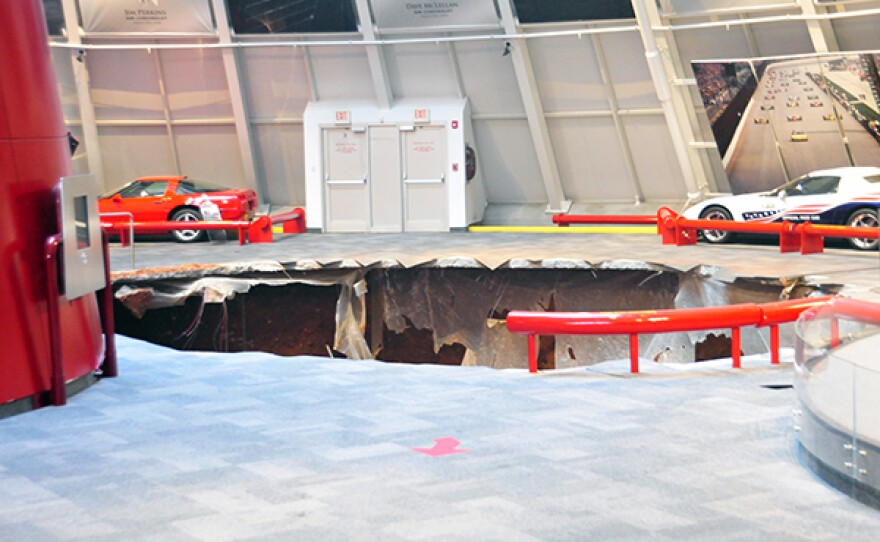The National Corvette Museum in Bowling Green will re-open to the public Thursday after a sinkhole collapse swallowed up eight of the iconic vehicles.
The collapse happened shortly after 5:30 a.m. Wednesday. The Bowling Green Fire Department responded to an alarm triggered by the sinkhole.
Security cameras at the museum captured the collapse, which took place in the Skydome portion of the facility where the museum shows off some of its most invaluable vehicles. Six of the Corvettes that fell into the sinkhole are owned by the museum, with the other two on loan from General Motors.
According to a news release by the museum, all cars on display in the Skydome not affected by the sinkhole have been safely removed from the area. That same release also said a structural engineering firm at the site has determined that the perimeter of the Skydome is stable.
Museum Executive Director Wendell Strode estimated the hole that opened up at the facility is 25 to 30 feet deep and 40 feet wide.
The sinkhole didn't come as a shock to WKU Geology Professor Jason Polk, who says recent rainfall may have played a role in Wednesday's collapse.
“We’ve had fairly moist conditions as far as the rainfall. It’s just the type of thing that happens when you have these events with what we have in Bowling Green, which is karst geology,” Polk told WKU Public Radio. “It could be a contributing factor, that’s certainly one cause of sinkholes that happen in places like this. But there could be a lot of different reasons why something like this would happen.”
Dr. Polk says natural sinkhole occurrences are exacerbated by changes in rainfall, groundwater usage, and human impacts. Sinkholes aren’t uncommon in Bowling Green, but it’s the first incidence of a sinkhole on the Corvette Museum property.
One of the cars trapped inside the earth following the collapse is the one-millionth Corvette ever produced. Bowling Green Assembly Corvette Club President David Chrisley was working at the plant in 1992 when the white vehicle was created.
"I was also there when the 2009 1.5 millionth car came off the line," Chrisley said. "And apparently both of those cars are in the hole, and you can't see them because they're underneath the two cars that you can see."
While Chrisley says it was hard for him to see the photographs of the sinkhole and the damaged cars that dropped into the earth, he's relieved the calamity didn't cause any injuries.
"There could have been a large tour in there, depending on how busy the day was. You know, there could have been a few, or there could have been 100. So it's a blessing that it happened before they opened.
Updated 2:52 p.m.
Officials say the Corvette Museum will re-open to the public on Thursday, but the Skydome portion where the sinkhole opened up Wednesday morning will remain closed. Museum officials say a structural engineer has deemed the remainder of the facilities safe.
Updated 2:14 p.m.
The sinkhole at the Corvette Museum wasn’t all that surprising to a WKU Geology professor, given Bowling Green’s karst landscape. Dr. Jason Polk says recent rainfall could have played a role in the collapse.
“We’ve had fairly moist conditions as far as the rainfall. It’s just the type of thing that happens when you have these events with what we have in Bowling Green which is karst geology,” Polk told WKU Public Radio's Lisa Autry. “It could be a contributing factor, that’s certainly one cause of sinkholes that happen in places like this. But there could be a lot of different reasons why something like this would happen.”
Dr. Polk says natural sinkhole occurrences are exacerbated by changes in rainfall, groundwater usage and human impacts. Sinkholes aren’t uncommon in Bowling Green, but it’s the first incidence of a sinkhole on the Corvette Museum property.
Updated 10:24 a.m.
Officials say the sinkhole that opened up at the Corvette Museum early Wednesday morning measured 25-30 feet deep and 40 feet wide. Eight cars were affected by the sinkhole, several others that were in the domed area of the museum remain in place. Museum officials say a structural engineer is on site and the museum will be closed to visitors on Wednesday.
Original post
A sinkhole has opened up beneath the National Corvette Museum, swallowing eights cars on display at the Bowling Green facility.
A news release from the museum says the Bowling Green Fire Department responded to an alarm that was triggered by the sinkhole shortly after 5:30 a.m.
Six of the corvettes that went into the sinkhole were owned by the museum, with two others on loan from General Motors.
Museum Executive Director Wendell Strode told the Daily News the hole is about 20 feet deep, and is located under the dome part of the building where several Corvettes are kept on display for tourists.
Strode says the cars will remain in the ground until a structural engineer arrives and evaluates how to proceed.
The cars on loan from GM are:
- 1993 ZR-1 Spyder on loan from General Motors
- 2009 ZR1 “Blue Devil” on loan from General Motors
The other six vehicles owned by the museum are:
- 1962 Black Corvette
- 1984 PPG Pace Car
- 1992 White 1 Millionth Corvette
- 1993 Ruby Red 40th Anniversary Corvette
- 2001 Mallett Hammer Z06 Corvette
- 2009 White 1.5 Millionth Corvette
WKU Public Radio's Lisa Autry is at the Corvette Museum to cover the story. Check back with us on the air and online throughout the day for more information as we learn it.







